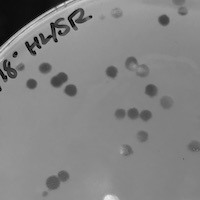Microbacterium phage LilPhiji
Add or modify phage thumbnail images to appear at the top of this page.
Know something about this phage that we don't? Modify its data.
| Detailed Information for Phage LilPhiji | |
| Discovery Information | |
| Isolation Host | Microbacterium foliorum NRRL B-24224 |
| Found By | Hetal Lad, Sophie Redila, Arathi Pillai |
| Year Found | 2018 |
| Location Found | Philadelphia, PA USA |
| Finding Institution | Drexel University |
| Program | Science Education Alliance-Phage Hunters Advancing Genomics and Evolutionary Science |
| From enriched soil sample? | Yes |
| Isolation Temperature | 22°C |
| GPS Coordinates | 39.955833 N, 75.183333 W Map |
| Discovery Notes | The soil was collected at 2:32 PM on October 3, 2018. This sample was collected from 5 cm below the soil surface found in front of the Lebow School of Business building. The soil was damp, but slightly hard to the touch. There were pieces of grass surrounding the area. |
| Naming Notes | Our phage has been through a lot, similar to that of a young upcoming music industry artist. Going through the struggles of being plated numerous times in order to be isolated and pure, she has experiences to tell the world. Thus, our phage is named as a rapper would call themselves: Lil Phiji. The "lil" in reference to Lil Uzi Vert and multiple other artists, and the "Phiji" in reference to phage/phagey. Additionally, the quality of her rapping is equivalent to the high quality of Fiji water, so her name suits her perfectly. |
| Sequencing Information | |
| Sequencing Complete? | No |
| Genome length (bp) | Unknown |
| Character of genome ends | Unknown |
| Fasta file available? | No |
| Characterization | |
| Cluster | Unclustered |
| Subcluster | -- |
| Annotating Institution | Unknown or unassigned |
| Annotation Status | Not sequenced |
| Plaque Notes | The plaques were clear and therefore the morphology was lysed. The plaques were all around 3 mm in diameter. This was an expected result of collecting a pure phage population. In order to produce these plaques, a plaque of 1 mm in diameter was picked and plated. This demonstrated how although the plaques are different sizes, they come from the same population. The bigger plaques were the more populous yet they came from a plaque that was small, and the plate produced contained big and small plaques. We can infer from this that they are all the same population. |
| Has been Phamerated? | No |
| Publication Info | |
| Uploaded to GenBank? | No |
| GenBank Accession | None yet |
| Refseq Number | None yet |
| Archiving Info | |
| Archiving status | Archived |
| Pitt Freezer Box# | 82 |
| Pitt Freezer Box Grid# | A2 |
| Available Files | |
| Plaque Picture | Download |
